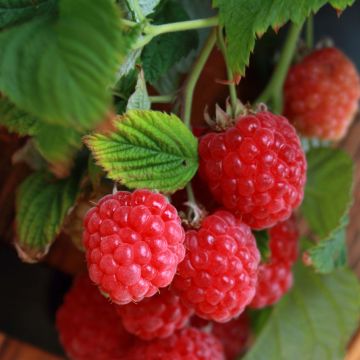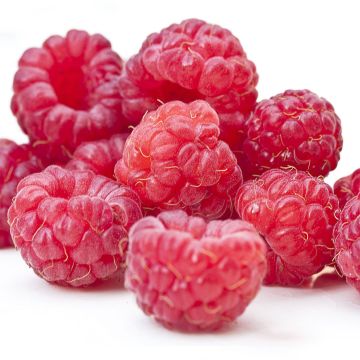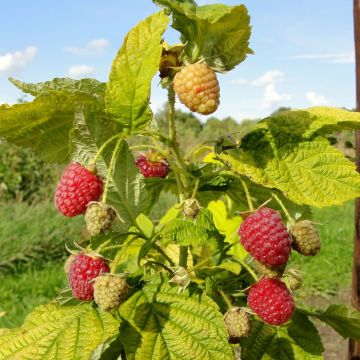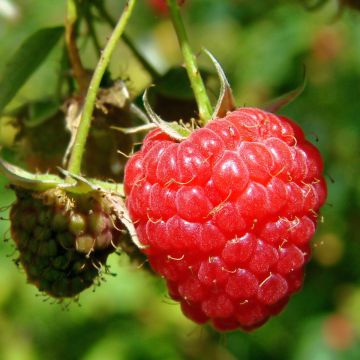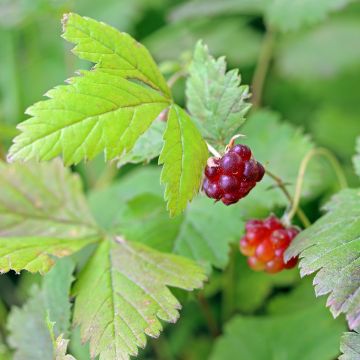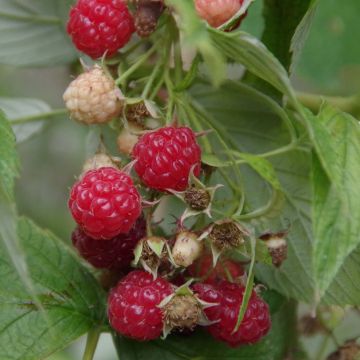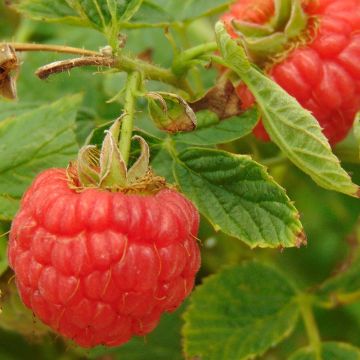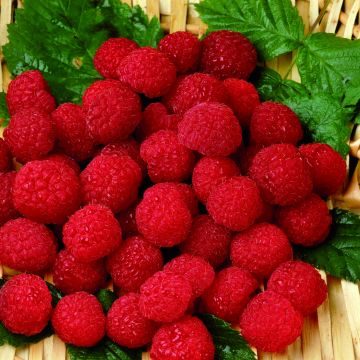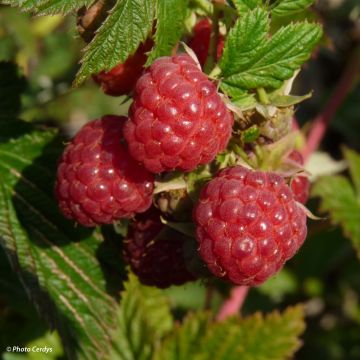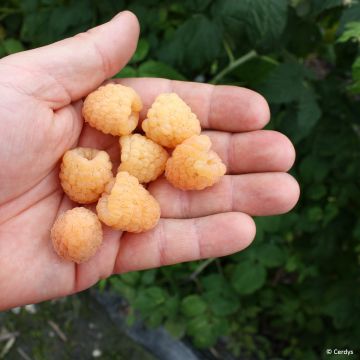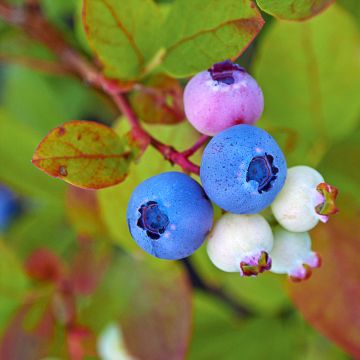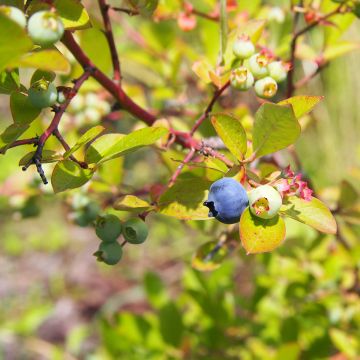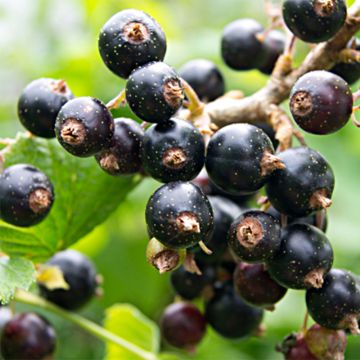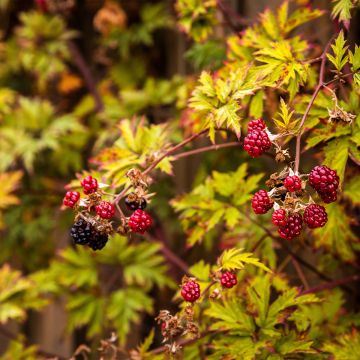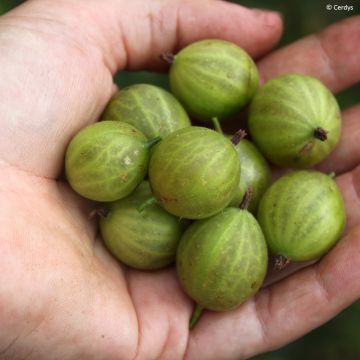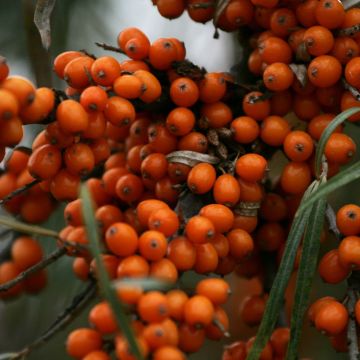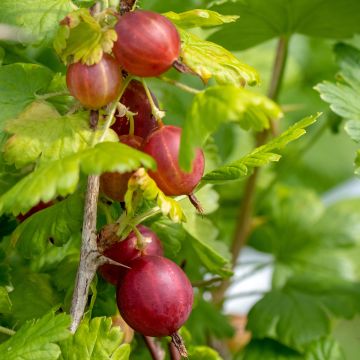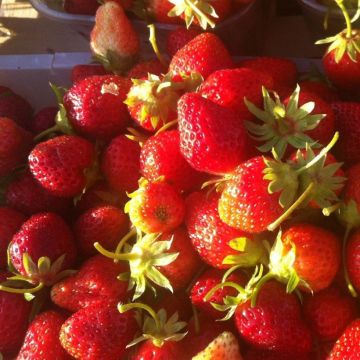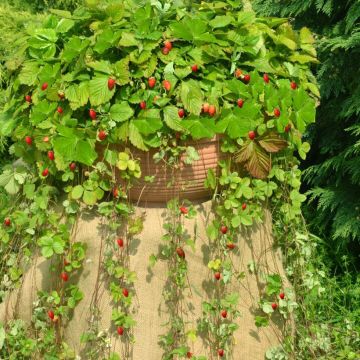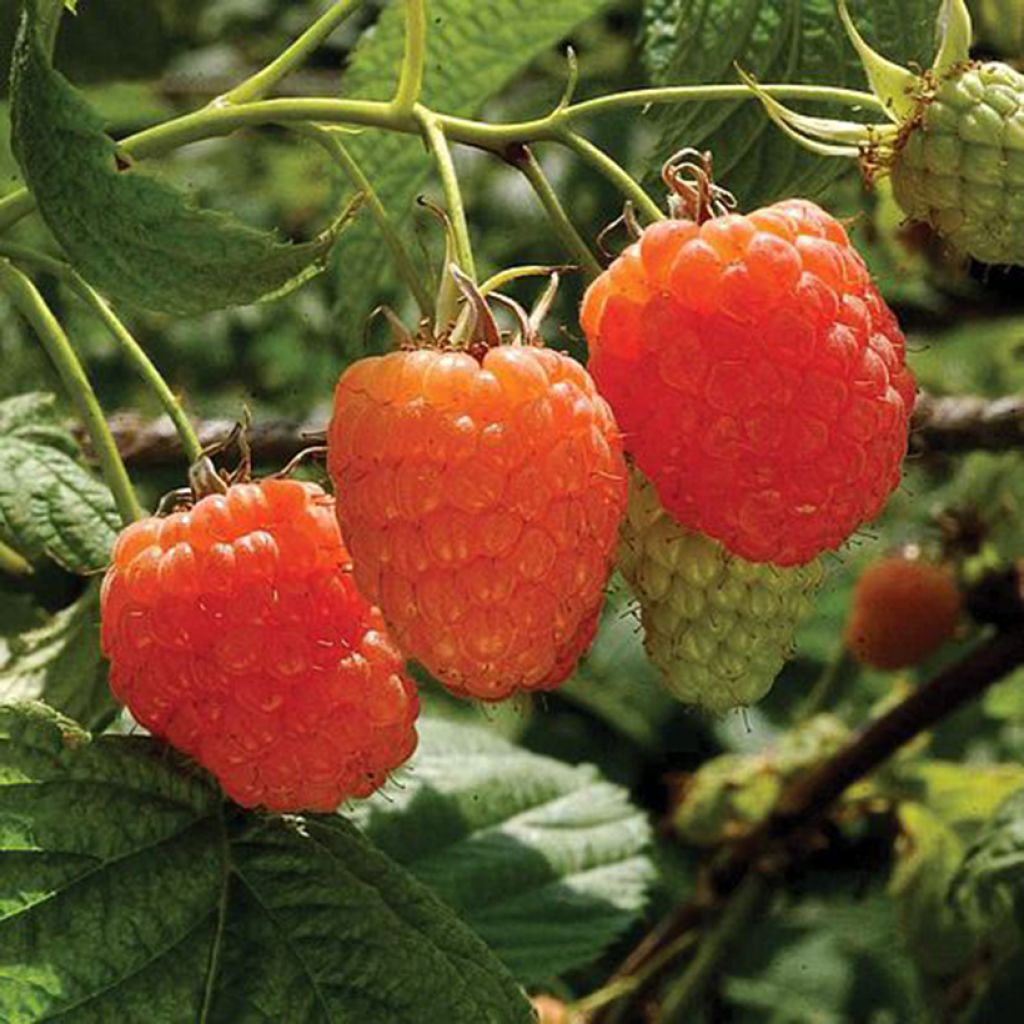

Raspberry Valentina - Rubus idaeus
Raspberry Valentina - Rubus idaeus
Rubus idaeus Valentina ®
Red Raspberry, European Red Raspberry
This item cannot be shipped to the selected country
Delivery charge from €5.90
More information
Schedule delivery date,
and select date in basket
This plant carries a 6 months recovery warranty
More information
We guarantee the quality of our plants for a full growing cycle, and will replace at our expense any plant that fails to recover under normal climatic and planting conditions.
From €5.90 for pickup delivery and €6.90 for home delivery
Express home delivery from €8.90.
Description
The 'Valentina' orange hybrid Raspberry, in Latin Rubus idaeus 'Valentina', is a recent variety that stands out for its beautiful apricot colour fruits. The medium to large, about 1.5 to 2 cm in diameter, slightly elongated heart-shaped raspberries are extremely tasty, with a sweet and fruity flavour, enhanced by a subtle bitterness. They are best consumed fresh after picking and are loved in jam, sorbet, or pastry. This Raspberry bush is not perpetual, it abundantly produces its fruits between late June and early August on the previous year's branches. It is self-fertile but to ensure continuous production and offer a varied range of flavours and uses, it is a good idea to cultivate it alongside other Raspberry varieties. It is best to plant this Raspberry variety in autumn or spring, particularly in regions with cold or humid winters. In addition, it has remarkable resistance to bad weather, tolerating temperatures as low as -20°C, and it is also disease-resistant. Its maintenance is easy and its cultivation requires little specific care.
Rubus idaeus, commonly known as Raspberry, native to Europe and temperate Asia, belongs to the Rosaceae family, like strawberries, blackberries, and wild roses. In its original habitat, it grows in the undergrowth in a cool climate, with plants such as rowan, elderberry, or beech, with which it forms a symbiotic association. Production reaches its peak in the third year after planting. The lifespan of the Raspberry bush is about ten years. There are two categories of Raspberry bushes. The remontant varieties produce two harvests, the first around June-July on the previous year's branches, and the second from August until the first frost on the young shoots of the year. The non-remontant varieties, with abundant harvest around June-July, bear fruit on the previous year's branches.
The 'Valentina' variety was obtained in 2017 by Hortifrut SA, a Chilean company. It is a hybrid variety that forms a bushy shrub that can reach 150 cm high and 80 cm wide. Its deciduous foliage is carried by upright stems, developing as a moderately suckering perennial crown. The canes are biennial, each dying after fruiting. Every year, new thornless canes emerge from its roots. The Raspberry bush leaves are green on the top, whitish-green and hairy on the underside. The flowering is very nectar-rich. In May-June, white, 1 to 2 cm diameter flowers appear in small clusters of 10 to 12. The fruits are formed by small agglomerated drupes, easy to detach when ripe.
The 'Valentina' Raspberry bush produces abundantly over a short period in July. The Raspberry is a delicate fruit that must be carefully picked, a light wash with water is possible, and it keeps better in the refrigerator. Picking is easy, and it is very pleasant either to enjoy the fruits on the spot or to collect them for various culinary uses: sorbets, coulis, jams, tiramisu, crumble, puddings... not to mention the traditional Raspberry Tart. Raspberries are low in calories but rich in minerals (calcium, magnesium, iron), vitamin C and K, fibre, and antioxidants so contribute to a good nutritional balance.
Within an edible hedge, in the vegetable garden, or in the ornamental garden, the Valentina Raspberry bush will find a special place alongside other small fruit varieties. To increase the diversity of colour and taste of raspberries, it can be useful to plant it near perpetual varieties, such as the Zeva and Heritage varieties, or coloured fruit varieties such as Golden Everest and Fall Gold with yellow fruits, or Glen Coe, a thornless variety with purple-violet fruits.
Report an error about the product description
Plant habit
Fruit
Flowering
Foliage
Botanical data
Rubus
idaeus
Valentina ®
Rosaceae
Red Raspberry, European Red Raspberry
Rubus idaeus 'Valentina'
Cultivar or hybrid
Other Raspberry plants
Planting and care
The Valentina Raspberry prefers humus-bearing, rich soils that retain moisture, even in summer, without too much limestone. It appreciates partially shaded but bright exposures. In the north, it will tolerate full sun, while in the south, it will prefer partial shade. Plant it from October to March in ordinary soil, enriched with compost and well-rotted manure.
Plant the canes every 80 cm in rows 1.50 m apart. During planting, the collar should be level with the ground. It is advisable to train them with wire stretched between stakes or on a trellis.
Water regularly to promote root growth in the first year of planting. During periods of high heat or prolonged drought, provide additional water. Weed the surface, especially at the beginning of planting and apply mulch to retain moisture in summer.
The Raspberry can be susceptible to various diseases if the growing conditions are not optimal (raspberry anthracnose, raspberry rust, powdery mildew, grey mould in rainy periods, or Botrytis). The damage observed in cultivation is generally due to poor weather conditions, especially during cold springs that allow micro-fungi present in the soil to infest the vegetation. To protect the plants, feed with organic fertilisers that promote the multiplication of anaerobic bacteria in the soil, which strengthens the soil's ability to stimulate the plants' immune system. Raspberries can also be attacked by parasites such as raspberry worms, the larvae of a small beetle that lodges on the fruits without causing significant damage.
Raspberries easily multiply through suckers that grow near the base: remove them and replant them in another part of the garden if desired.
Planting period
Intended location
Care
This item has not been reviewed yet - be the first to leave a review about it.
Berries
Haven't found what you were looking for?
Hardiness is the lowest winter temperature a plant can endure without suffering serious damage or even dying. However, hardiness is affected by location (a sheltered area, such as a patio), protection (winter cover) and soil type (hardiness is improved by well-drained soil).

Photo Sharing Terms & Conditions
In order to encourage gardeners to interact and share their experiences, Promesse de fleurs offers various media enabling content to be uploaded onto its Site - in particular via the ‘Photo sharing’ module.
The User agrees to refrain from:
- Posting any content that is illegal, prejudicial, insulting, racist, inciteful to hatred, revisionist, contrary to public decency, that infringes on privacy or on the privacy rights of third parties, in particular the publicity rights of persons and goods, intellectual property rights, or the right to privacy.
- Submitting content on behalf of a third party;
- Impersonate the identity of a third party and/or publish any personal information about a third party;
In general, the User undertakes to refrain from any unethical behaviour.
All Content (in particular text, comments, files, images, photos, videos, creative works, etc.), which may be subject to property or intellectual property rights, image or other private rights, shall remain the property of the User, subject to the limited rights granted by the terms of the licence granted by Promesse de fleurs as stated below. Users are at liberty to publish or not to publish such Content on the Site, notably via the ‘Photo Sharing’ facility, and accept that this Content shall be made public and freely accessible, notably on the Internet.
Users further acknowledge, undertake to have ,and guarantee that they hold all necessary rights and permissions to publish such material on the Site, in particular with regard to the legislation in force pertaining to any privacy, property, intellectual property, image, or contractual rights, or rights of any other nature. By publishing such Content on the Site, Users acknowledge accepting full liability as publishers of the Content within the meaning of the law, and grant Promesse de fleurs, free of charge, an inclusive, worldwide licence for the said Content for the entire duration of its publication, including all reproduction, representation, up/downloading, displaying, performing, transmission, and storage rights.
Users also grant permission for their name to be linked to the Content and accept that this link may not always be made available.
By engaging in posting material, Users consent to their Content becoming automatically accessible on the Internet, in particular on other sites and/or blogs and/or web pages of the Promesse de fleurs site, including in particular social pages and the Promesse de fleurs catalogue.
Users may secure the removal of entrusted content free of charge by issuing a simple request via our contact form.
The flowering period indicated on our website applies to countries and regions located in USDA zone 8 (France, the United Kingdom, Ireland, the Netherlands, etc.)
It will vary according to where you live:
- In zones 9 to 10 (Italy, Spain, Greece, etc.), flowering will occur about 2 to 4 weeks earlier.
- In zones 6 to 7 (Germany, Poland, Slovenia, and lower mountainous regions), flowering will be delayed by 2 to 3 weeks.
- In zone 5 (Central Europe, Scandinavia), blooming will be delayed by 3 to 5 weeks.
In temperate climates, pruning of spring-flowering shrubs (forsythia, spireas, etc.) should be done just after flowering.
Pruning of summer-flowering shrubs (Indian Lilac, Perovskia, etc.) can be done in winter or spring.
In cold regions as well as with frost-sensitive plants, avoid pruning too early when severe frosts may still occur.
The planting period indicated on our website applies to countries and regions located in USDA zone 8 (France, United Kingdom, Ireland, Netherlands).
It will vary according to where you live:
- In Mediterranean zones (Marseille, Madrid, Milan, etc.), autumn and winter are the best planting periods.
- In continental zones (Strasbourg, Munich, Vienna, etc.), delay planting by 2 to 3 weeks in spring and bring it forward by 2 to 4 weeks in autumn.
- In mountainous regions (the Alps, Pyrenees, Carpathians, etc.), it is best to plant in late spring (May-June) or late summer (August-September).
The harvesting period indicated on our website applies to countries and regions in USDA zone 8 (France, England, Ireland, the Netherlands).
In colder areas (Scandinavia, Poland, Austria...) fruit and vegetable harvests are likely to be delayed by 3-4 weeks.
In warmer areas (Italy, Spain, Greece, etc.), harvesting will probably take place earlier, depending on weather conditions.
The sowing periods indicated on our website apply to countries and regions within USDA Zone 8 (France, UK, Ireland, Netherlands).
In colder areas (Scandinavia, Poland, Austria...), delay any outdoor sowing by 3-4 weeks, or sow under glass.
In warmer climes (Italy, Spain, Greece, etc.), bring outdoor sowing forward by a few weeks.

































